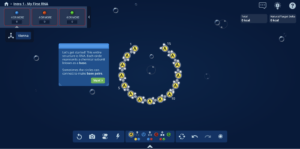EteRNA by Rhiju Das and Adrien Treuille
EteRNA is a game about RNA folding, allowing players to learn how base pairs combine to change RNA molecule shapes. It also offers the possibility of creating entirely new ways fold RNA molecules.
The game provides a number of kinds of play, including the “challenge” of manipulating complex chemistry to solve for a particular target shape, the “discovery” of learning about how RNA molecules work, and the “sensation” provided by the game’s clean and engaging aesthetic.
The game was a highly effective application of the MDAO framework. It’s clear the game designers, a group of scientists funded by organizations concerned with educating the public on health and science issues, began with identifying and “understanding the nature of the desired outcomes.” Namely, the game sought to educate more of the public about the important science of RNA folding, which is fundamental to medicines like mRNA vaccines. There is also the underlying objective of open-sourcing medical research, with the game claiming “no computer” can solve all the game’s challenges and that, by playing, anyone can “help advance medical research.” This focus on learning outcomes and public benefit aligns with the MDAO implementation/design strategy of beginning with outcomes and working through layers of abstraction toward the underlying mechanics.
What jumps out immediately as a player is how aesthetically appealing the game is. An RNA learning game could easily be boring or intimidating, but the EterRNA creators used color, sound, and a clean layout to inject excitement and positive feedback, effectively using my senses to achieve the “sensation” form of fun.

Image: The game greets the player on the first puzzle with a clean display that utilizes mostly primary colors on a soothing blue backdrop, lots of unused space, and a central toolbar with easy-to-understand icons. The player is provided with plain-language, click-through tutorials that introduce only the tools needed to solve the puzzle at hand. As puzzles become progressively more difficult in subsequent levels, the walk-through tutorials reappear to introduce new tools and concepts.

Image: The clean, primary color aesthetic of the game erupts into intense color beams and bubbles when you solve a puzzle.
This helped to pull me into the game and keep me engaged with what was relatively sophisticated and challenging content. These aesthetics were supported and triggered by simple, clean underlying dynamics and mechanics. The only tool I needed, other than reading, was the mouse click. Single clicks were enough to replace and flip bases, as well as move between the natural and target views. I could easily imagine creating a bunch of different tools for manipulating the complex chemistry of RNA molecules, but because the designers prioritized the clean, engaging aesthetic, they managed to keep the mechanics streamlined. This allowed a dynamic of unencumbered problem-solving and learning to emerge.
While I can’t know for sure without being in the room, the experience of the game felt like a highly competent application of MDAO that succeeded in achieving an ambitious outcome. It’s easy to imagine how a game about RNA folding might fail, berating the player with overly dense academic content and complex controls. But EteRNA’s developers, by starting with outcomes and prioritizing aesthetics and then adding dynamics and mechanics “designed to support the decisions made in the previous levels of design,” (Browning, 127) I emerged from the game significantly more knowledgeable about challenging subject matter than I entered.



